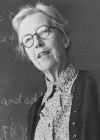
December 17, 1900 - April 3, 1998

December 17, 1900 - April 3, 1998
During the 1940's Mary Cartwright worked with John Littlewood on the solutions of the Van der Pol equation and discovered many of the phenomena that later became known as "chaos". In his review of Ian Stewart's book, Nature's Numbers, Dyson writes about this work
Cartwright had been working with Littlewod on the solutions of the [ Van der Pol] equation, which describe the output of a nonlinear radio amplifier when the input is a pure sine-wave. The whole development of radio in World War Two depended on highpower amplifiers, and it was a matter of life and death to have amplifiers that did what they were supposed to do. The soldiers were plaqued with amplifliers that misbehaved, and blamed the manufacturers for their erratic behavior. Cartwright and Littlewood discovered that the manufacturers were not to blame. The equation itself was to blame. They discovered that as you raise the gain of the amplifier, the solutions of the equation become more and more irregular. At low power the solution has the same period as the input, but as the power increases you see solutions with double the period, and finally you have solutions that are not periodic at all.Cartwright had a distinguished career in analytic function theory and university administration, publishing numerous papers on classical analysis, differential equations and related topological problems. In 1947 Cartwright became the first woman mathematician to be elected as a Fellow of the Royal Society of England. She was elected President of the London Mathematical Society in 1951, received the Sylvester Medal of the Royal Society in 1964, the De Morgan Medal of the London Mathematical Society in 1968, and in 1969 became Dame Mary Cartwright (the female equivalent of a knighthood).
After her retirement Cartwright held visiting professorships at universities in England, America, and Poland. She died in Cambridge on April 3, 1998.
![[Photo Credits]](camera.gif)